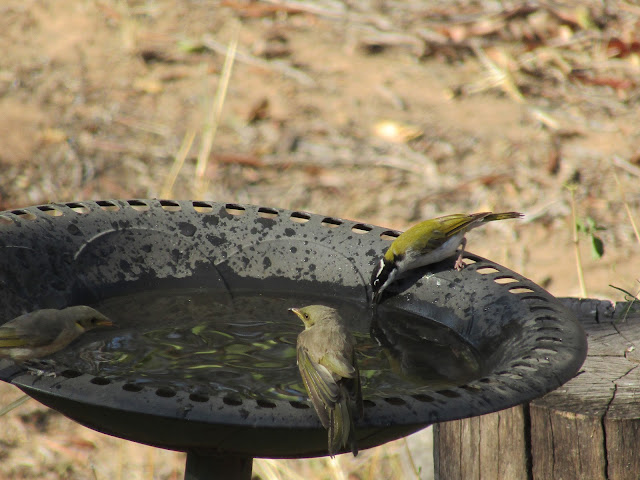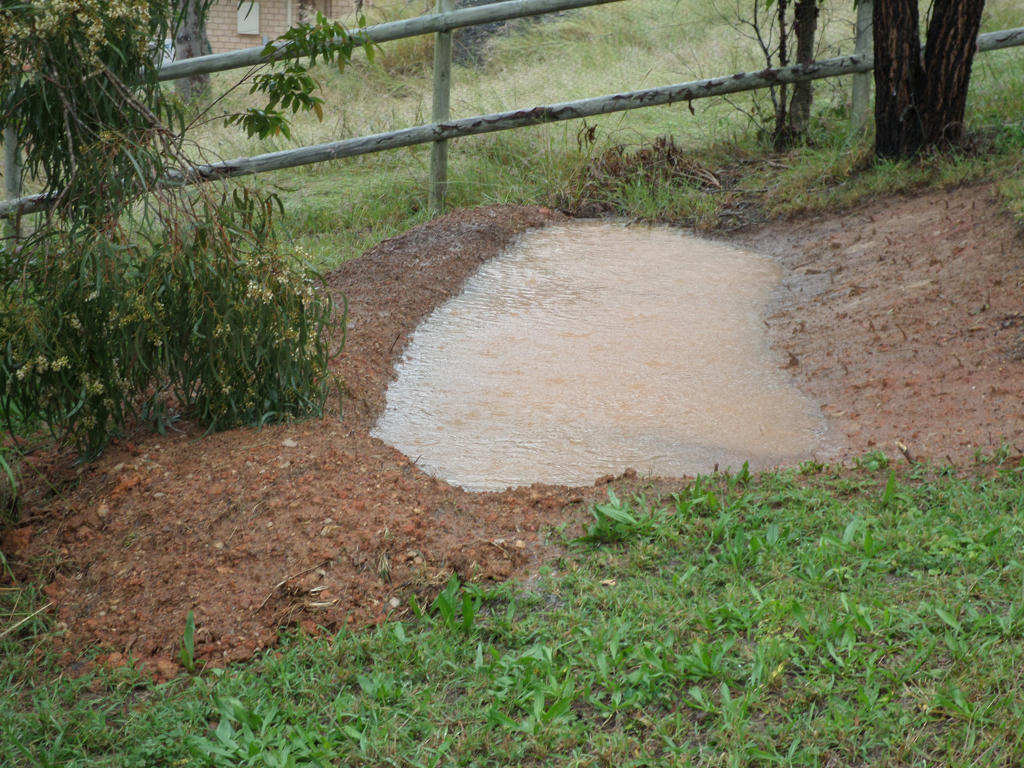Dust-pan
Since all the natural watering holes, in the landscape have dried up, our bird-baths have been working overtime. They're filled twice a day now, to accommodate the visitors. Which is about 18 litres of water, per day. We have the larger bath, for mostly birds and adult kangaroos to drink from. The small one is for Joeys, who have vacated mum's pouch. But not quite large enough, to reach the tall one yet. We've had different configurations over the years.
The smaller bowl was a more recent addition, due to the drought. Around 2017, it was added, when our main gully stopped flooding. Mama Roo's were drinking, but juvenile Joeys were stretching up, and couldn't reach. It was great to see them be able to reach water, at ground level again. As that's where we originally had the bowl - just sitting on the ground. But there was one small problem, with that.
Juvenile
As we lost more and more ground cover, due to Roo traffic and lack of rain, it became quite a dust bowl. We were wasting water, rinsing out the accumulated mud, from the bottom. So we raised it up on a sandstone plinth, we were gifted. It made all the difference too. Now the Joey's had a much cleaner bowl to drink from, and we could just top it up.
While watching the bird-baths, yesterday afternoon, this Joey remained drinking continuously, for five minutes. Possibly more. I left after five minutes, and they were still drinking. Thirsty guy. This is why we're constantly filling them up. Add a mob of kangaroos, plus the numerous flocks of birds, and that's where it all goes.
I took quite a few photos of different birds, using the bath too. I wasn't sure, what this bird was at first. Possibly a Wren, or a Monarch? Took me some researching online, as it wasn't in my usual Bird Finder. But I'm fairly certain now, it's a Leaden Flycatcher. It's a migratory bird in this part of Queensland, which is why I don't see it as regularly as other birds.
I loved it's colouration though, and it blended perfectly into the bronzing landscape.
Drinking in the background, is a White-throated Honeyeater - I think? Looks very similar to the White-naped Honeyeater, only lacks the orange eyeliner. It's funny how similar species of birds can look, with just the slightest variation. Makes it a bit confusing to identify.
I don't know what the bird in the foreground is though. Perhaps another Honeyeater? Could be similar to the one, below...
Although another variation of Honeyeater, these ones are different again. More grey looking all over, with a yellow tuft, under the cheek. You can usually tell it's a honeyeater, by the shape of it's beak. It tapers down to a narrow point, so it can access the flower blooms.
All the bird visitors, are usually quick at the birdbath though. They drink. They splash. Squabble. Then leave. Knowing predatory birds, see the watering hole as an opportunity too.
I was fortunate to capture these elusive parrots, at the birdbath too. They were incredibly suspicious, of me taking pictures. I was about 20 metres away, at the back of the house - but they didn't come down to drink for ages. Choosing to hang around the trees, chortling, instead. Eventually they could avoid the watering hole, no longer. But they were watching me, the whole time.
The smaller birds usually don't care, if I'm taking pictures. It's the larger ones, which are more timid.
Drinking with the Lorikeets, were several Noisy Friarbirds - only caught one in this shot though. If you click on the link, you'll hear it's call, by selecting the audio file on the right-hand menu. It's a very familiar sound to me. They look like mini vultures with their bare necks and head.
While they are largely nectar feeders, they will also be opportunistic and eat eggs or small birds. So maybe not that unrelated to vultures.
This is just a fraction of what comes to visit our man-made, watering hole. Interesting nonetheless, to get some photos and learn exactly what kinds of birds are visiting.
May 2015
I'll be honest with you guys, however. I'm REALLY starting to miss taking pictures of our swales filling up. They haven't served their purpose, for at least two years now. 2017, was the last time our main gully flooded. Nothing significant has fallen, since. So the ground is extremely thirsty. Whatever does fall in the swale, ends-up being absorbed rather quickly.
While our two birdbaths, perform a critical service in the interim. I do miss seeing the larger amounts of water in the landscape. Specifically, the interaction it brings to the animals and plants. At least some parts of Queensland, are finally seeing some significant rainfall though. Which is good to hear. Maybe our turn will come around soon, and I'll be snapping full swales again?
I'm reluctant to write about this aspect of property ownership - or the destitute years. Where everything seems to fail around you. Endeavours, you poured your heart and soul into, evaporates, like the water. And there's nothing which can be done, but wait. It's part of the cycle though. The highs of seeing a string of full swales, match the lows of dust pan central, as far as the eye can see. They're just on different ends of the spectrum.
New earthworks
If you cannot learn to manage in-between, of the extremes, life on the land becomes very challenging. Your thoughts will relentlessly bounce between hope and doubts. Which is nothing but an energy sap. Stopping you from doing what CAN be done, anywhere in the spectrum.
In the dry (for us) is the opportunity to create more water capturing earthworks. We're making slow progress on a new pond, first mentioned in this post, at the beginning of the year. Instead of focusing on empty swales, I put those fears and doubts to work, building new vessels to hold water. Then I'll have countless more opportunities, once the rain arrives again, to sink that water in. I still miss the full swales, but I'm not stuck in no-man's land, just waiting either.
I like what our new neighbours' kids, are using there empty dam for though - a mountain bike ramp/jump, thingy. Which is a lot of fun for them, and adds value to the energy, installing the dam. So even in the dry it serves a purpose. In the destitute years, it takes a lot of creativity to find that connection again. To what you're doing. Despite the fact, there seems to be very little return.
What are you presently doing, that's calling for your creativity?










The animals will be appreciating that water, Chris, as there's so little in the landscape for them. They are lucky to have custodians who think of them too. We've noticed an increase in the number of parrots here, particularly Pale Headed Rosellas and King Parrots, coming in to our birdbaths and native flowering shrubs.
ReplyDeleteWe've just had a hail storm come through; more hail than rain in it. I hope there's been some rainfall out at your place and that the fires are keeping their distance. MegXx
It's great to hear, you're putting out water too. Birds are looking for new water sources, all over. I've noticed a lot more bird calls in our area, because of this. Yikes. Hail! I hope your cars were under cover. Maybe it's making way for the rain to come?. That would be so welcome, by everyone in South-East Queensland, I think. :)
DeleteI have had you on my mind after your last post and the risk of fire. UK is a wet country, and very wet in the midlands at this moment, so to read your struggles in such a long dry period is interesting. It's good to read you look after your wildlife, here we feed birds all through the year, but at this time it's really important to ensure they have food. I hope the rain comes soon.
ReplyDeleteThanks M. The extremes are global, it seems. Floods and fire. Helping the wildlife out, during these times, is the least we can do. Considering all the benefits they bring to our landscape. It's great to hear, you're helping them out, in your part of the world too. :)
DeleteGrreat reading your blog post
ReplyDelete